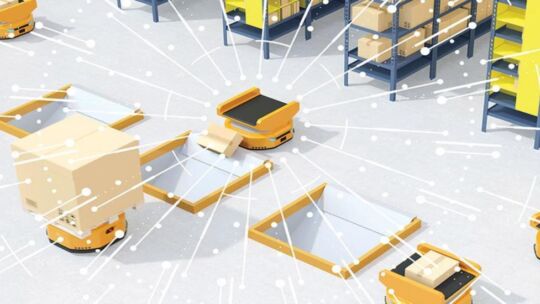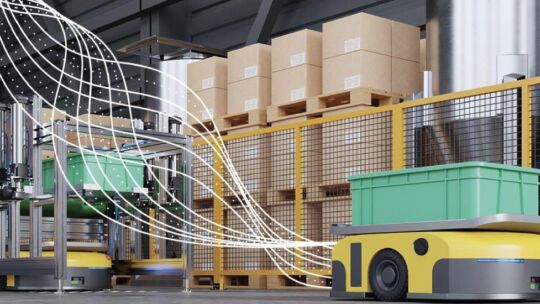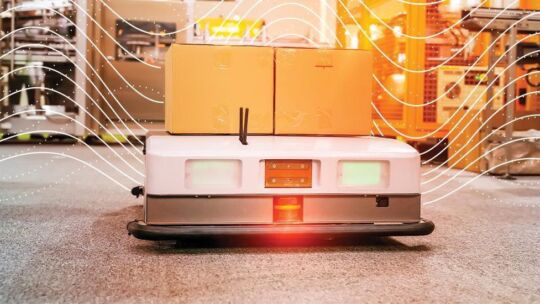
To remain competitive and respond quickly to market changes, commercial and industrial applications are embracing Industry 4.0. This new way of doing business is driven by data, connectivity, and automation, helping to improve operations, reduce downtime, and increase profits.

One growth area that relies on automation are large manufacturing and warehouse facilities used by industries such as automotive, electronics, pharmaceuticals, and e-commerce. The most significant component in manufacturing and warehouse automation is the dependence on autonomous mobile robots, or AMRs, to transport products and supplies from one location to another in these enormous facilities.
AMRs are robots that understand and navigate environments with minimal intervention by human operators and are not restricted to a fixed, pre-determined path. They rely on vision cameras, onboard sensors, artificial intelligence, and guidance software to operate as expected. Tasks are assigned to the AMR as needed from an operator located on the manufacturing floor using a tablet, smartphone, or computer.
AMRs help address resource challenges and perform repetitive tasks with speed and efficiency, freeing up employees to perform higher-level tasks. They provide operating and location data to operators using data driven analytics to track its performance.
At Flex, we know the benefits of AMRs and use them in our advanced manufacturing warehouse facilities. AMRs bring supplies to automated manufacturing lines, move components from one location to another for the next steps, and transport the final product to the loading dock to be shipped out to the customer. The robot operator assigns tasks, tracks its location, and responds to issues or obstacles via a tablet, smartphone, or computer. Data analytics are collected when the robot is operating and used to enhance performance and safety features now and on future AMRs.
As AMRs become more prevalent in warehouse and manufacturing operations, their roles and responsibilities will expand, driven by technological advances. AMRs, with their additional duties, that work in a shared environment with humans will mean that safety will continue to be a critical focus when building these robots. As an advanced manufacturing partner, we have extensive experience designing and building AMRs for a wide range of uses across different industries for our customers.
Critical safety considerations for AMRs
A safe AMR is built by innovative engineering and reliable hardware. We have the deep expertise and technological resources to design AMRs for our customers’ operations with less design risk and lower cost of ownership. Our team is knowledgeable in European and North American safety regulations and requirements that apply to AMRs.
Our engineers focus on the following functional and electrical safety considerations from the very beginning when designing and manufacturing AMRs for our customers.
Functional safety
AMRs are designed to collaborate with people, interact with the environment, manage intentional misuse, and enable product durability in the workspace.
Flex relies on two comprehensive industry-standard assessments that identify environmental and design issues with AMRs:
- Hazard and Risk Analysis (HARA) is a tops-down approach that identifies all hazardous scenarios that can occur between AMRs, humans and the environment and categorizes them by severity for assessment.
- Failure Modes and Effects Analysis (FMEA) is a bottoms-up approach that identifies all possible failures in a design, including components, assemblies and subsystems.
Flex engineers determine whether the safety goals have been attained by performing diagnostics to assess the impact of each failure mode (FMEA) and hazard (HARA) to determine whether the safety goals are attained. If not, the cycle is repeated by adding or enhancing the design until the goals have been reached.
Additionally, our robotics experts verify that the AMR operates as designed and validate all safety features perform as intended. These assessments satisfy the applicable functional safety requirements of a customer AMR.
Electrical safety
AMRs require batteries, motors, computers, sensors, as well as a charger for battery replenishment during downtime. We carefully design AMRs and chargers to meet the required electrical safety standards and have them certified by a nationally approved regulatory body.
Testing and Validation of AMRs
We partner with certified labs to conduct regulatory and engineering tests, ensuring AMRs meet or exceed safety requirements. These tests validate the systems for mandated risk assessments and government safety and engineering requirements.
After designing and engineering the AMR, we work with our supply chain experts to procure robotic-specific components for the manufacturing process that meet safety requirements.
Designing, engineering, and testing AMRs with safety in mind
As AMRs become more common in manufacturing facilities, their roles and responsibilities will expand as technology advances and business needs evolve across industries. The added tasks mean that safety will continue to be a significant factor to consider when designing future generations of AMRs. Flex experts include safety in the design and engineering of AMRs. Internal and external testing will confirm the AMR’s performance to ensure the machine operates as intended.
Partner with Flex to design, validate, and manufacture AMRs with safety in mind and begin taking advantage automation’s vast benefits.
Learn more about how we are accelerating innovation in the growing and ever-evolving robotics market.



